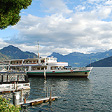GLACIER GARDEN OF LUCERNE
Ice Age Geology for the Familiy in Old Swiss City Center
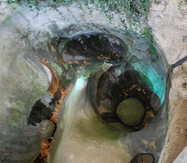 On
a crisp November morning in 1872 Josef Wilhelm Amrein-Troller was supervising
the digging of
a wine cellar
for his fine house in spreading
suburb just outside the old medieval city walls of Lucerne, when his
workmen uncovered some very strange rock formations. Impossibly smooth
round boulders
On
a crisp November morning in 1872 Josef Wilhelm Amrein-Troller was supervising
the digging of
a wine cellar
for his fine house in spreading
suburb just outside the old medieval city walls of Lucerne, when his
workmen uncovered some very strange rock formations. Impossibly smooth
round boulders 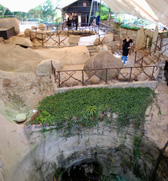 and
deep pothole cavelets in the hillside. What he had discovered was the
remnant record of the Ice Age in central Switzerland,
once completely covered in glaciers which now only remain on the high
mountains. The glacial polish of the stones and holes provide the evidence
of the action of glaciers. A year later, the Swiss businessman opened
his “Glacier Garden” (Gletschergarten) to the public as a
tourist attraction. Over a century later, Amrein-Trollers house as well
has perhaps become consumed by his rock garden, housing its Glacier Museum
and
deep pothole cavelets in the hillside. What he had discovered was the
remnant record of the Ice Age in central Switzerland,
once completely covered in glaciers which now only remain on the high
mountains. The glacial polish of the stones and holes provide the evidence
of the action of glaciers. A year later, the Swiss businessman opened
his “Glacier Garden” (Gletschergarten) to the public as a
tourist attraction. Over a century later, Amrein-Trollers house as well
has perhaps become consumed by his rock garden, housing its Glacier Museum
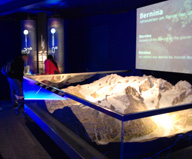 The
Glacier Garden attraction in Lucerne offers a variety of sights for
the casual afternoon for
the family or just the curious. A strolling path
underneath a canvas canopy
added in 1980 leads through the exposed pre-historic geologic formations
of potholes created by the force of water unable to escape under the
crushing weight of slow moving glaciers. The round granite boulders,
one as heavy as five tons, which lie about the hillside like toys left
scattered by a giant’s children, were carried by the moving ice
from high in the mountains to where they rest. The house which stands
next to the glacial garden is a beautiful example of a Swiss house of
the 1800’s. It remains much as when the Amrein-Troller family had
lived within its walls, antique Biedermeier furniture and Baroque bedroom
designs.
The
Glacier Garden attraction in Lucerne offers a variety of sights for
the casual afternoon for
the family or just the curious. A strolling path
underneath a canvas canopy
added in 1980 leads through the exposed pre-historic geologic formations
of potholes created by the force of water unable to escape under the
crushing weight of slow moving glaciers. The round granite boulders,
one as heavy as five tons, which lie about the hillside like toys left
scattered by a giant’s children, were carried by the moving ice
from high in the mountains to where they rest. The house which stands
next to the glacial garden is a beautiful example of a Swiss house of
the 1800’s. It remains much as when the Amrein-Troller family had
lived within its walls, antique Biedermeier furniture and Baroque bedroom
designs. 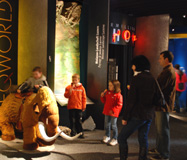 A portrait of the family stands opposite the rich wood main
stairway, dominated by a painting of the Glacier Garden as it appeared
in the 1800's. Much of the lower floors of the house are taken up by
the Glacier Museum, with interactive exhibits explaining the formation
and action of glaciers, relief detail models of the Engadine Bernina
region (see Bernina
Express Alps Scenic Rail) from where Lucerne’s glacial
activity originated. One of the world’s oldest relief landscape
scale maps of the Swiss Alps was created by pioneering Swiss cartographer
Franz Ludwig Pfyffer von Wyher. In the GeoWorld Luzern exhibit, the evolution
of ice age man and geologic history of Lucerne is presented with large
scale oil paintings depicting Lucerne during the Ice Age. A cast recreation
of a Baby Mammoth seems quite the attraction for kids to climb on to
have a picture taken by mom and dad.
A portrait of the family stands opposite the rich wood main
stairway, dominated by a painting of the Glacier Garden as it appeared
in the 1800's. Much of the lower floors of the house are taken up by
the Glacier Museum, with interactive exhibits explaining the formation
and action of glaciers, relief detail models of the Engadine Bernina
region (see Bernina
Express Alps Scenic Rail) from where Lucerne’s glacial
activity originated. One of the world’s oldest relief landscape
scale maps of the Swiss Alps was created by pioneering Swiss cartographer
Franz Ludwig Pfyffer von Wyher. In the GeoWorld Luzern exhibit, the evolution
of ice age man and geologic history of Lucerne is presented with large
scale oil paintings depicting Lucerne during the Ice Age. A cast recreation
of a Baby Mammoth seems quite the attraction for kids to climb on to
have a picture taken by mom and dad.
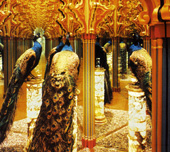 A
path behind the house leads up to the old mountain chalet which the
1800’s headquarters of
the Swiss Alpine Club and the observation tower with a view over Lucerne
from
the lake to Mt. Pilatus (see Mt
Pilatus Lucerne). On the lower level below the house,
the Hall of Mirrors of the Alhambra, (based on a Spanish-Moor version),
which
was created
for the Swiss national exhibition in Geneva in 1899 confounds with mirrored
corridors seeming infinite in an optical illusion, reflecting ornate
gold gilt and sculptured peacocks. Outside the mirror hall are a series
distortion funhouse mirrors.
A
path behind the house leads up to the old mountain chalet which the
1800’s headquarters of
the Swiss Alpine Club and the observation tower with a view over Lucerne
from
the lake to Mt. Pilatus (see Mt
Pilatus Lucerne). On the lower level below the house,
the Hall of Mirrors of the Alhambra, (based on a Spanish-Moor version),
which
was created
for the Swiss national exhibition in Geneva in 1899 confounds with mirrored
corridors seeming infinite in an optical illusion, reflecting ornate
gold gilt and sculptured peacocks. Outside the mirror hall are a series
distortion funhouse mirrors.
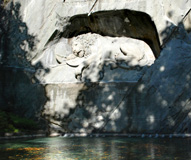 The
entrance to the Glacier Garden of Lucerne is next to the iconic famous
Lion of Lucerne, the
relief figure
of a reclining feline carved
into the sheer wall of sandstone left from the quarry where much of the
stone which built the old city of Lucerne was cut. The lion represents
the defeat of the Swiss Guard during the storming of the Tuileries Palace
in Paris in 1792, but he seems more sad in the serene setting than defeated.
He rest just across the pool of water among the trees, a popular backdrop
for a tourist group photo. The Glacier Garden located on Denkmalstrasse,
literally “monument
street”, is also very near the Bourbaki Panorama exhibit for a
twofer tour afternoon in Lucerne (see Bourbaki
Panorama).
The
entrance to the Glacier Garden of Lucerne is next to the iconic famous
Lion of Lucerne, the
relief figure
of a reclining feline carved
into the sheer wall of sandstone left from the quarry where much of the
stone which built the old city of Lucerne was cut. The lion represents
the defeat of the Swiss Guard during the storming of the Tuileries Palace
in Paris in 1792, but he seems more sad in the serene setting than defeated.
He rest just across the pool of water among the trees, a popular backdrop
for a tourist group photo. The Glacier Garden located on Denkmalstrasse,
literally “monument
street”, is also very near the Bourbaki Panorama exhibit for a
twofer tour afternoon in Lucerne (see Bourbaki
Panorama).
Visiting the Glacier Garden Lucerne
The Gletschergarten Luzern is open daily year round from 9 am to 6pm April 1 to October 31, and 10 am to 5 pm, November 1 to March 31. Entrance fee for adults is 15 CHF, 12 CHF Seniors and Students, 8 CHF for children 6 to 16. You can get a Lion Pass that includes the Glacier Garden and Bourbaki Panorama for 22 CHF for adults and 12 CHF for kids and students. If you’re traveling with a Swiss Rail Pass, museums are free. © Bargain Travel Europe
Find best hotel and vacation deals for Lucerne on TripAdvisor
Web Info
Gletschergarten
Luzern
These articles are copyrighted and the sole property of Bargain Travel Europe and WLPV, LLC. and may not be copied or reprinted without permission.
SEE ALSO:
BUCHERER "AION" ROLLING
BALL CLOCK
SWISS
TRANSPORT MUSEUM
NEW
YEAR’S DAY FIREWORKS - LUCERNE

